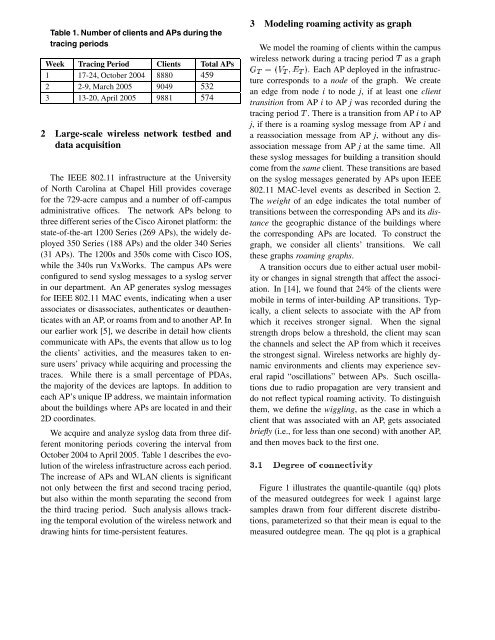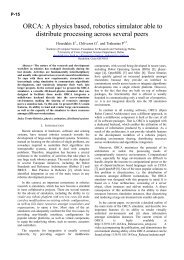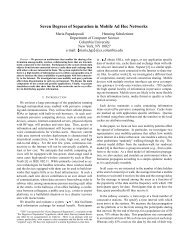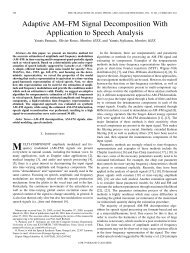Modeling Roaming in Large-scale Wireless Networks using Real ...
Modeling Roaming in Large-scale Wireless Networks using Real ...
Modeling Roaming in Large-scale Wireless Networks using Real ...
You also want an ePaper? Increase the reach of your titles
YUMPU automatically turns print PDFs into web optimized ePapers that Google loves.
Table 1. Number of clients and APs dur<strong>in</strong>g the<br />
trac<strong>in</strong>g periods<br />
Week Trac<strong>in</strong>g Period Clients Total APs<br />
1 17-24, October 2004 8880 459<br />
2 2-9, March 2005 9049 532<br />
3 13-20, April 2005 9881 574<br />
2 <strong>Large</strong>-<strong>scale</strong> wireless network testbed and<br />
data acquisition<br />
The IEEE 802.11 <strong>in</strong>frastructure at the University<br />
of North Carol<strong>in</strong>a at Chapel Hill provides coverage<br />
for the 729-acre campus and a number of off-campus<br />
adm<strong>in</strong>istrative offices. The network APs belong to<br />
three different series of the Cisco Aironet platform: the<br />
state-of-the-art 1200 Series (269 APs), the widely deployed<br />
350 Series (188 APs) and the older 340 Series<br />
(31 APs). The 1200s and 350s come with Cisco IOS,<br />
while the 340s run VxWorks. The campus APs were<br />
configured to send syslog messages to a syslog server<br />
<strong>in</strong> our department. An AP generates syslog messages<br />
for IEEE 802.11 MAC events, <strong>in</strong>dicat<strong>in</strong>g when a user<br />
associates or disassociates, authenticates or deauthenticates<br />
with an AP, or roams from and to another AP. In<br />
our earlier work [5], we describe <strong>in</strong> detail how clients<br />
communicate with APs, the events that allow us to log<br />
the clients’ activities, and the measures taken to ensure<br />
users’ privacy while acquir<strong>in</strong>g and process<strong>in</strong>g the<br />
traces. While there is a small percentage of PDAs,<br />
the majority of the devices are laptops. In addition to<br />
each AP’s unique IP address, we ma<strong>in</strong>ta<strong>in</strong> <strong>in</strong>formation<br />
about the build<strong>in</strong>gs where APs are located <strong>in</strong> and their<br />
2D coord<strong>in</strong>ates.<br />
We acquire and analyze syslog data from three different<br />
monitor<strong>in</strong>g periods cover<strong>in</strong>g the <strong>in</strong>terval from<br />
October 2004 to April 2005. Table 1 describes the evolution<br />
of the wireless <strong>in</strong>frastructure across each period.<br />
The <strong>in</strong>crease of APs and WLAN clients is significant<br />
not only between the first and second trac<strong>in</strong>g period,<br />
but also with<strong>in</strong> the month separat<strong>in</strong>g the second from<br />
the third trac<strong>in</strong>g period. Such analysis allows track<strong>in</strong>g<br />
the temporal evolution of the wireless network and<br />
draw<strong>in</strong>g h<strong>in</strong>ts for time-persistent features.<br />
3 <strong>Model<strong>in</strong>g</strong> roam<strong>in</strong>g activity as graph<br />
We model the roam<strong>in</strong>g of clients with<strong>in</strong> the campus<br />
wireless network dur<strong>in</strong>g a trac<strong>in</strong>g period T as a graph<br />
G T =(V T E T ). Each AP deployed <strong>in</strong> the <strong>in</strong>frastructure<br />
corresponds to a node of the graph. We create<br />
an edge from node i to node j, if at least one client<br />
transition from AP i to AP j was recorded dur<strong>in</strong>g the<br />
trac<strong>in</strong>g period T . There is a transition from AP i to AP<br />
j, if there is a roam<strong>in</strong>g syslog message from AP i and<br />
a reassociation message from AP j, without any disassociation<br />
message from AP j at the same time. All<br />
these syslog messages for build<strong>in</strong>g a transition should<br />
come from the same client. These transitions are based<br />
on the syslog messages generated by APs upon IEEE<br />
802.11 MAC-level events as described <strong>in</strong> Section 2.<br />
The weight of an edge <strong>in</strong>dicates the total number of<br />
transitions between the correspond<strong>in</strong>g APs and its distance<br />
the geographic distance of the build<strong>in</strong>gs where<br />
the correspond<strong>in</strong>g APs are located. To construct the<br />
graph, we consider all clients’ transitions. We call<br />
these graphs roam<strong>in</strong>g graphs.<br />
A transition occurs due to either actual user mobility<br />
or changes <strong>in</strong> signal strength that affect the association.<br />
In [14], we found that 24% of the clients were<br />
mobile <strong>in</strong> terms of <strong>in</strong>ter-build<strong>in</strong>g AP transitions. Typically,<br />
a client selects to associate with the AP from<br />
which it receives stronger signal. When the signal<br />
strength drops below a threshold, the client may scan<br />
the channels and select the AP from which it receives<br />
the strongest signal. <strong>Wireless</strong> networks are highly dynamic<br />
environments and clients may experience several<br />
rapid “oscillations” between APs. Such oscillations<br />
due to radio propagation are very transient and<br />
do not reflect typical roam<strong>in</strong>g activity. To dist<strong>in</strong>guish<br />
them, we def<strong>in</strong>e the wiggl<strong>in</strong>g, as the case <strong>in</strong> which a<br />
client that was associated with an AP, gets associated<br />
briefly (i.e., for less than one second) with another AP,<br />
and then moves back to the first one.<br />
3.1 Degree of connectivity<br />
Figure 1 illustrates the quantile-quantile (qq) plots<br />
of the measured outdegrees for week 1 aga<strong>in</strong>st large<br />
samples drawn from four different discrete distributions,<br />
parameterized so that their mean is equal to the<br />
measured outdegree mean. The qq plot is a graphical
















